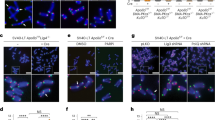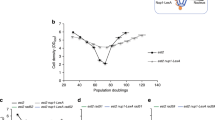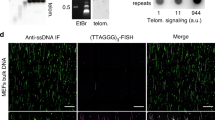Abstract
The telomerase ribonucleoprotein complex caps chromosome ends by adding telomeric repeats. Here we show that catalytically active human telomerase has a regulated intranuclear localization that is dependent on the cell-cycle stage, transformation and DNA damage. In primary cell lines, low expression of a fusion protein of green fluorescent protein and telomerase reverse transcriptase (GFP–hTERT) increases telomerase activity and stabilizes the maintenance of telomere length. Confocal microscopy shows that the release of telomerase to the nucleoplasm from sequestration at nucleolar sites is enhanced at the expected time of telomere replication. By contrast, in tumour and transformed cells, there is an almost complete dissociation of telomerase from nucleoli at all stages of the cell cycle. Transfection of the simian virus 40 genome into a primary cell line is sufficient to mobilize telomerase from nucleoli to the nucleoplasm. Conversely, ionizing radiation induces the reassociation of telomerase with nucleoli in both primary and transformed cells. These findings show that transformation and DNA damage have opposite effects on the cellular regulation of active telomerase, affecting the enzyme's access to both telomeric and nontelomeric substrates.
This is a preview of subscription content, access via your institution
Access options
Subscribe to this journal
Receive 12 print issues and online access
$209.00 per year
only $17.42 per issue
Buy this article
- Purchase on Springer Link
- Instant access to full article PDF
Prices may be subject to local taxes which are calculated during checkout





Similar content being viewed by others
References
McEachern, M. J., Krauskopf, A. & Blackburn, E. H. Annu. Rev. Genet. 34, 331–358 (2000).
Blackburn, E. H. Nature Struct. Biol. 7, 847–850 (2000).
Stewart, S. A. & Weinberg, R. A. Semin. Cancer Biol. 10, 399–406 (2000).
Shay, J. W. & Bacchetti, S. Eur. J. Cancer 33, 787–791 (1997).
Mitchell, J. R. & Collins, K. Oncogene 21, 564–579 (2002).
Counter, C. M. et al. Proc. Natl Acad. Sci. USA 95, 14723–14728 (1998).
Mitchell, J. R., Wood, E. & Collins, K. Nature 402, 551–555 (1999).
Newport, J. & Yan, H. Curr. Opin. Cell Biol. 8, 365–368 (1996).
Griffith, J. D. et al. Cell 97, 503–514 (1999).
Holt, S. E., Aisner, D. L., Shay, J. W. & Wright, W. E. Proc. Natl Acad. Sci. USA 94, 10687–10692 (1997).
Bryan, T. M., Englezou, A., Gupta, J., Bacchetti, S. & Reddel, R. R. EMBO J. 14, 4240–4248 (1995).
Wright, W. E., Pereira-Smith, O. M. & Shay, J. W. Mol. Cell. Biol. 9, 3088–3092 (1989).
Marcand, S., Brevet, V., Mann, C. & Gilson, E. Curr. Biol. 10, 487–490 (2000).
Zhu, J., Wang, H., Bishop, J. M. & Blackburn, E. H. Proc. Natl Acad. Sci. USA 96, 3723–3728 (1999).
O'Hare, M. J. et al. Proc. Natl Acad. Sci. USA 98, 646–651 (2001).
Sprung, C. N., Reynolds, G. E., Jasin, M. & Murnane, J. P. Proc. Natl Acad. Sci. USA 96, 6781–6786 (1999).
Lusky, M. & Botchan, M. Nature 293, 79–81 (1981).
Acknowledgements
We thank D. Schichnes, S. Ruzin and H. Nolla for technical help; P. Kaminker, J. Campisi, J. Shay, W. Wright and M. Botchan for reagents; and members of the Collins laboratory for discussion and comments.
Author information
Authors and Affiliations
Corresponding author
Ethics declarations
Competing interests
The authors declare no competing financial interests.
Supplementary information
Supplementary figures and table
Figure S1 (PDF 644 kb)
Figure S2
Figure S3
Table S1
Rights and permissions
About this article
Cite this article
Wong, J., Kusdra, L. & Collins, K. Subnuclear shuttling of human telomerase induced by transformation and DNA damage. Nat Cell Biol 4, 731–736 (2002). https://doi.org/10.1038/ncb846
Received:
Revised:
Accepted:
Published:
Issue Date:
DOI: https://doi.org/10.1038/ncb846
This article is cited by
-
A novel two-step genome editing strategy with CRISPR-Cas9 provides new insights into telomerase action and TERT gene expression
Genome Biology (2015)
-
Anthracyclines disrupt telomere maintenance by telomerase through inducing PinX1 ubiquitination and degradation
Oncogene (2012)
-
Telomerase promotes efficient cell cycle kinetics and confers growth advantage to telomerase-negative transformed human cells
Oncogene (2012)
-
Human telomerase activity regulation
Molecular Biology Reports (2011)
-
Localization of an hTERT repressor region on human chromosome 3p21.3 using chromosome engineering
Genome Integrity (2010)



